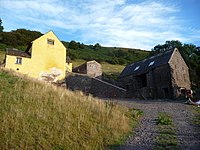Ty-Hwnt-y-Bwlch Farmhouse, Cwmyoy


Ty-Hwnt-y-Bwlch Farmhouse, (Welsh: translation - The house near the pass), Cwmyoy, Monmouthshire is a farmhouse in the north of the county dating from the late 16th century. Located on the hillside above the Church of St Martin, it is a Grade II* listed building.
History
The architectural historian John Newman calls Ty-Hwnt-y-Bwlch "a lonely farmstead" and describes its site as "a hillside which one would think too steep to make a practical site for building".[1] The farmhouse dates from the late 16th century,[2] with additions in the 17th century and is of a Welsh longhouse plan.[1] Cadw records that it is reputed to include elements taken from Llanthony Priory including the arch to the porch.[2] At the time of the Cadw surveys in the late 20th century, the building was "in poor condition" but renovation has subsequently been undertaken.[3]
Architecture and description
Ty-Hwnt-y-Bwlch is constructed in stone to a L-plan and is "exceptionally unaltered".[2] The interior has an elaborate doorcase, carved with "stags, hounds, harps and leaves".[1] The Royal Commission on the Ancient and Historical Monuments of Wales notes the presence of a medieval arch.[4] The house is listed Grade II*.[2] The barn, dating from the 1720s,[5] and stables, which date from the 19th century, have their own Grade II listings.[6] The courtyard wall to the north of the farmhouse incorporates a set of bee boles.[2]
Gallery
-
 A rear view of the farmhouse
A rear view of the farmhouse -
 The farmhouse and ancillary buildings
The farmhouse and ancillary buildings
Notes
- ^ a b c Newman 2000, p. 211.
- ^ a b c d e Cadw. "Ty-Hwnt-y-Bwlch Farmhouse (Grade II*) (15659)". National Historic Assets of Wales. Retrieved 10 August 2020.
- ^ "Tŷ Hwnt y Bwlch". Alwyn Jones Architects. Retrieved 11 August 2020.
- ^ "Ty-hwnt-y-bwlch (20996)". Coflein. RCAHMW. Retrieved 29 September 2021.
- ^ Cadw. "Barn at Ty-Hwnt-y-Bwlch Farmhouse (Grade II) (15658)". National Historic Assets of Wales. Retrieved 10 August 2020.
- ^ Cadw. "Stables at Ty-Hwnt-y-Bwlch Farmhouse (Grade II) (15660)". National Historic Assets of Wales. Retrieved 10 August 2020.
References
- Newman, John (2000). Gwent/Monmouthshire. The Buildings of Wales. London: Penguin. ISBN 0-14-071053-1.
External links
- Royal Commission on the Ancient and Historical Monuments of Wales (Coflein) entry with images












